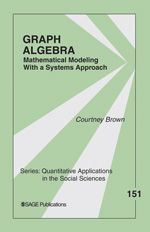From the publisher's description of the book: Graph Algebra: Mathematical Modeling with a Systems Approach introduces a new modeling tool to students and researchers in the social sciences. Derived from engineering literature that uses similar techniques to map electronic circuits and physical systems, graph algebra utilizes a systems approach to modeling that offers social scientists a variety of tools that are both sophisticated and easily applied. Key Features:  Designed for readers in the social sciences with minimal mathematical training: In this volume, the author assists readers in developing their own difference and differential equation model specifications. Designed for readers in the social sciences with minimal mathematical training: In this volume, the author assists readers in developing their own difference and differential equation model specifications.
 Incorporates Social Theory: This book describes an easily applied language of mathematical modeling that uses boxes and arrows to develop very sophisticated algebraic statements of social and political phenomena. Graph algebra can be used to algebraically “flesh-out” even the most complicated and sophisticated of theories. Incorporates Social Theory: This book describes an easily applied language of mathematical modeling that uses boxes and arrows to develop very sophisticated algebraic statements of social and political phenomena. Graph algebra can be used to algebraically “flesh-out” even the most complicated and sophisticated of theories.
 Contains social science examples of graph algebra models: Social science readers can see many examples of how graph algebra can be used to model theories from a wide variety of substantive areas and disciplines. The book also describes how to estimate such models, and two examples are fully worked out. Contains social science examples of graph algebra models: Social science readers can see many examples of how graph algebra can be used to model theories from a wide variety of substantive areas and disciplines. The book also describes how to estimate such models, and two examples are fully worked out.
 Explains linear and nonlinear model specifications using graph algebra from a social science perspective: Readers can move beyond simple linear regression models by using graph algebra. Explains linear and nonlinear model specifications using graph algebra from a social science perspective: Readers can move beyond simple linear regression models by using graph algebra.
This text is ideal for use in graduate courses such as Statistical Modeling, Quantitative Methods, and Applied Mathematics.
Table of Contents - Systems Analysis
Structure and Function
An Overview of the Substantive Examples Found in Subsequent Chapters - Graph Algebra Basics
Inputs, Outputs, and the Forward Path
Feedback Loops and Mason’s Rule
An Example from Economics: The Keynesian Multiplier - Graph Algebra and Discrete-Time Linear Operators
Delay and Advance Operators for Discrete Time
Including an Additive Constant with Graph Algebra
Difference and Summation Operators for Discrete Time
A Note Regarding Additive Constants
An Estimated Example: Labor Union Membership - Working with Systems of Equations
Richardson’s Arms Race Model Using Graph Algebra
Variations of Richardson’s Arms Race Model
An Estimated Example of a Multiple Equation System with Nonlinear or Embedded Parameters: Richardson’s Arms Race - Applying Graph Algebra to Continuous Time
Using Graph Algebra with Continuous-Time Operators - Graph Algebra and Nonlinearity
Nonlinear Filters
The Logistic Function
Delays and Instability
Placement Rules for Operators in Nonlinear Models
Graph Algebra and Chaos
Forced Oscillators - Working with Conditional Paths
Logical and Decision Systems
An Example of Democratic Transition
An Evolutionary Example - Systems, Shocks, and Stochasticity
- Graph Algebra and Social Theory
Systems and Equilibria
References
Index
About the Author
| 
